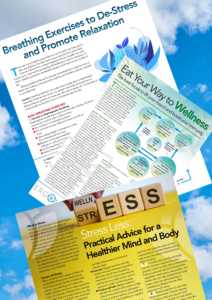 April marks Stress Awareness Month, an annual event dedicated to raising awareness of stress, its effects, and ways to manage it effectively. It serves as a vital opportunity to highlight the impact of stress on both personal and professional wellbeing, encourage open conversations, and promote strategies that support mental and physical health.
April marks Stress Awareness Month, an annual event dedicated to raising awareness of stress, its effects, and ways to manage it effectively. It serves as a vital opportunity to highlight the impact of stress on both personal and professional wellbeing, encourage open conversations, and promote strategies that support mental and physical health.
Stress is an inevitable part of life. We all experience it in various forms. While moderate stress can motivate individuals to achieve goals and perform well under pressure, prolonged or excessive stress can quickly become overwhelming. If not addressed, it may contribute to mental health challenges such as burnout, anxiety, or depression, as well as physical issues like fatigue, headaches, and musculoskeletal pain, and disrupted sleep. Poor sleep, in turn, can exacerbate stress and create a vicious cycle. In the workplace, unmanaged stress can lead to reduced productivity, increased errors and accidents, and higher employee turnover. Recognising the signs of stress early and implementing effective management strategies is crucial for maintaining both personal and professional wellbeing.
When stress persist over time, it can escalate into burnout – state of physical, emotional, and mental exhaustion caused by chronic stress. Burnout can significantly impact an individual’s ability to function in both personal and professional settings. Recognising its early signs is essential to preventing long-term health consequences and protect both individual wellbeing and workplace performance.
Workplace stress is a significant concern. According to the Health and Safety Executive (HSE), work-related stress, depression, and anxiety resulted in 16.4 million lost working days in 2023/2024, with affected employees taking an average of 21.1 days off each. These conditions accounted for 46% of all work-related ill-health cases and 54% of all lost working days during this period (HSE, 2025).
Tips for Employers to Manage Workplace Stress
Conduct Regular Stress Risk Assessments
Employers have a legal duty to protect workers from stress at work, which includes conducting a stress risk assessment. Just like other health and safety risks, stress needs to be assessed and managed. Stressors such as workload, lack of support, job insecurity, and poor work-life balance should be identified and mitigated.
Create Holistic Wellbeing Strategies
A holistic approach to wellbeing encompasses physical, mental, emotional, social, and environmental health. Employers should design and implement wellbeing strategies that promote balance across all these areas. This could include offering wellbeing programmes, encouraging regular physical activity, fostering a supportive work environment, providing access to mental health resources, and addressing the social and environmental factors that influence employee wellbeing.
Implement Zero-Tolerance Policies for Bullying and Harassment
Workplace bullying and harassment are significant sources of stress. Employers should establish and enforce clear zero-tolerance policies regarding bullying, discrimination, and harassment. These policies should be communicated clearly to all staff, with specific procedures in place for reporting and addressing incidents.
Foster Open Communication
Encourage an open dialogue about stress in the workplace. Promote an environment where employees feel comfortable discussing their stress without fear of judgment or reprisal. This can be achieved through regular team meetings, anonymous surveys, or one-on-one discussions with managers. Ensuring a culture of transparency can help employees feel heard and supported.
Provide Resources and Support
Offer resources such as health and wellbeing workshops, evidence-based wellbeing content, and access to counselling services to help employees manage stress effectively. Ensure that employees are aware of where to turn for support when they need it, whether it’s through Employee Assistance Programmes (EAPs), peer support networks, or professional health services.
Encourage a Healthy Work-Life Balance
Help employees manage their time effectively by promoting flexibility and encouraging regular breaks. Discourage overwork by supporting flexible working hours or the option to work from home. When employees can maintain a healthy work-life balance, it helps prevent burnout, reduce stress levels, and support general health and wellbeing.
Check in About Workload and Challenges
Regularly check in with employees about their workload and any challenges they might be facing. Monitoring workloads and identifying any signs of stress or burnout early can allow managers to take proactive measures. Offering support with time management or redistributing tasks when necessary can reduce unnecessary pressure on staff.
Encourage Employees to Look After Their Own Mental Health
Encourage employees to take responsibility for their mental health by promoting self-care practices such as mindfulness, regular physical activity, and seeking professional help when necessary. Provide evidence-based wellbeing resources, reminders, and tips to help employees integrate these practices into their daily routines. This could include offering access to mental health resources, as well as resources on sleep, nutrition, and exercise, while consistently reminding them of the importance of taking regular breaks. Creating a supportive work environment where employees feel empowered to care for their mental health can significantly enhance their overall wellbeing.
Support Physical Health to Enhance Mental Wellbeing
Physical health directly impacts mental wellbeing. Employers should support physical health by providing ergonomic workstations, conducting regular DSE (Display Screen Equipment) workstation assessments, and encouraging frequent breaks and lunch away from the desk. Promoting movement and exercise is key in preventing and alleviating stress and musculoskeletal injuries. Additionally, offering health screenings and fitness-related benefits can support employees’ health and wellbeing, helping to reduce stress and improve productivity.
Train Managers to Recognise Early Signs of Stress and Burnout
Ensure managers are equipped with the skills to recognise early signs of stress and burnout. This includes understanding when to offer flexible working arrangements, make reasonable adjustments, and refer employees to EAPs. Additionally, promoting a healthy work-life balance and acknowledging and appreciating employees for their hard work can also help prevent excessive pressure and reduce stress in the workplace.
Support Managers Accordingly
Managers need adequate support and resources to be effective in their role. Providing managers with training on managing stress within teams, offering access to support resources like EAPs, and ensuring they have the tools to deal with mental health issues can make a big difference in the work culture. Well-supported managers are more likely to foster a healthy, productive team.
Offer Awareness Training for Issues that May Impact Employees’ Mental Health
To further support a healthy work environment, offer training to raise awareness of issues that may impact employees’ mental health, such as menopause, neurodivergence, or disabilities. This training should be available to both managers and employees. It helps everyone understand how these conditions may affect wellbeing, the potential challenges they may present in the workplace, and how to offer support. Encouraging open conversations around these topics fosters an environment where employees feel comfortable discussing personal health challenges and seeking the necessary support. By providing this training to all, employers create an inclusive, supportive work environment where employees feel valued and understood, which is essential for wellbeing.
Foster a Culture of Care and Collaboration
Build a workplace culture where employees feel cared for, supported, and encouraged to collaborate. Encourage teamwork, respect, and inclusivity in all work practices. When employees feel connected to their colleagues and supported by their employers, stress levels are often lower, and morale is higher.
Leaders to Model Healthy Work Habits
Leadership plays a crucial role in fostering a healthy work environment. Leaders should model positive work habits, such as setting boundaries, taking breaks, prioritising self-care, and maintaining a work-life balance. By demonstrating these behaviours, they show employees that prioritising mental and physical health is not only acceptable but encouraged.
Establish Clear Mental Health Policies
Having clear, transparent mental health policies in place ensures that employees know what support is available to them and what they can expect in times of need. These policies should include guidance on how to access mental health resources, how to approach management with concerns, and the steps for requesting accommodations or adjustments. Clear policies foster trust and show employees that their wellbeing is a priority.
Tips for Employees to Manage Stress
Employees can also take steps to manage stress and protect their wellbeing. Here are some tips for managing stress at work:
Recognise the Signs of Stress
The first step in managing stress is recognising it. Symptoms of stress can include irritability, difficulty concentrating, sleep disturbances, or physical signs like headaches and muscle tension. Being aware of these signs early allows you to take action before stress becomes overwhelming. Regularly check in with yourself to assess how you’re feeling and identify any signs of stress.
Use the Stress Bucket Concept
The Stress Bucket is a useful tool to help us understand how stress builds up over time. Imagine stress accumulating like rain filling a bucket. Each stressor in life—such as workload, poor sleep, money worries, or relationship issues—adds more “rain” to the bucket. Some stressors are within our control, while others are not. Everyone has a limit, and when the bucket overflows, it can lead to mental and/or physical health issues. To prevent this, it’s important to regularly ‘empty the bucket’ by opening the tap—engaging in stress-reducing activities like taking breaks, talking about your stress, exercising, or practicing relaxation techniques. This allows the accumulated stress to flow out, preventing the bucket from overflowing. By staying proactive in managing your stress, you can protect your mental and physical health.
Take Regular Breaks
Taking short breaks throughout the day can help clear your mind and reduce stress. A few minutes away from your desk, whether it’s for a walk or stretching can help you refocus and feel refreshed. This simple practice can prevent burnout, increase productivity, and improve overall wellbeing. Make breaks a regular part of your day to maintain a balanced work routine.
Set Work-Life Boundaries
Setting clear work-life boundaries is essential for managing stress and maintaining mental wellbeing. Ensure that your work doesn’t encroach upon your personal time by scheduling breaks, setting limits on when you work, and learning to switch off from work when you’re at home. Establishing these boundaries helps you recharge and prevents work from becoming a constant source of stress. Remember, time away from work is just as important as time spent working.
Set Realistic Goals
Setting realistic, achievable goals is crucial to preventing stress. Break down tasks into manageable steps and prioritise them based on importance and urgency. By setting clear, attainable goals, you can stay focused and reduce feelings of overwhelm. Celebrate small successes along the way to stay motivated and recognise your progress.
Stay Organised
Having a clear structure for your day can reduce stress by giving you a sense of control over your tasks. Use tools like to-do lists, calendars, or project management apps to help you stay organised and on top of your responsibilities. Prioritising tasks and breaking them down into smaller, more manageable pieces can help reduce feelings of being overwhelmed and prevent procrastination.
Exercise and Stay Active
Regular exercise is one of the best ways to reduce stress. Physical activity releases endorphins, natural mood boosters that help alleviate tension. Activities like walking, yoga, Pilates, gardening or even stretching can help release physical stress stored in your body. Incorporating regular movement into both your workday and personal time not only helps reduce stress but also enhances your physical and mental health. Try to find an activity you enjoy so it becomes a consistent part of your routine.
Practice Mindfulness and Relaxation Techniques
Techniques such as deep breathing, meditation, or mindfulness can help reduce the physical and emotional effects of stress. Even a few minutes of mindfulness during your workday can help calm your mind, improve focus, and enhance your emotional resilience. Consider taking a short break to practice deep breathing or mindfulness whenever you feel your stress levels rising.
Practice Gratitude
Taking a moment each day to reflect on what you’re grateful for, whether it’s at work or in your personal life, can help shift your mindset and reduce stress. Focusing on the positive aspects of your day can help counteract the negative effects of stress and foster a more resilient attitude. Consider starting or ending your day by listing three things you’re thankful for.
Engage in Creative or Enjoyable Hobbies
Outside of work, engage in hobbies or activities that bring you joy and help you unwind. Whether it’s painting, cooking, gardening, or reading, finding time for creative pursuits can serve as a healthy escape and stress reliever. Engaging in activities that you enjoy allows you to disconnect from work and recharge mentally and emotionally.
Cultivate Positive Relationships
Building strong, positive relationships with colleagues can act as a strong buffer against stress. Having a support network at work where you can share your thoughts and experiences with others who understand can provide emotional relief. Socialising, even in small ways, such as grabbing a coffee with a colleague, can enhance your sense of connection and reduce stress.
Prioritise Sleep for Stress Management
Quality sleep is essential for managing stress and supporting your mental and physical health. Ensure you get enough sleep each night by establishing a consistent sleep schedule and creating a restful environment. Lack of sleep can exacerbate stress and impact your ability to concentrate and make decisions. Prioritise good sleep hygiene by winding down before bed and limiting screen time to help you rest better.
Maintain a Balanced Diet
What you eat can affect how you handle stress. A nutritious, well-balanced diet, including plenty of fruits, vegetables, whole grains, and lean proteins, can help support mental and physical health. While it’s important to eat regularly, try to avoid over-reliance on caffeine or sugary snacks as these can contribute to stress and mood swings. Staying hydrated also plays a key role in maintaining focus and reducing stress levels.
Seek Support When Needed
If stress becomes overwhelming, don’t hesitate to reach out for support. Speaking to a manager, a colleague, a friend, or a professional such as your GP or counsellor can help you manage stress more effectively. Sometimes, just talking about what you’re experiencing can offer relief and provide clarity. Remember, seeking support is a sign of strength, not weakness.
Utilise Work Support
Take advantage of resources available at work, such as EAPs, to access counselling services, mental health resources, and stress management tools. These programs are designed to support you in managing stress and other personal or professional challenges. Don’t hesitate to reach out to these services if you feel you need additional support to manage your stress.
By recognising and proactively addressing stress, both employers and employees can work together to create a healthier, more supportive, and productive work environment. Stress management is not just an individual responsibility but a collective one that involves open communication, appropriate resources, and a culture that promotes mental health. This Stress Awareness Month, let’s come together to raise awareness, reduce the stigma surrounding stress, and implement effective strategies to manage stress in the workplace. By fostering an environment where employees feel supported and empowered to manage stress, we can build resilience, enhance health and wellbeing, and ultimately achieve a more productive and thriving workplace.
Want to create a healthier, more resilient workforce? Explore the Ergonix Wellbeing Hub for expert-led workplace wellbeing content, workshops, DSE assessments and DSE workstation assessor training. Get in touch today!
If you need support:
Useful reading:
HSE Stress Management Standards
Tackling work-related stress using the Management Standards approach (HSE)
The Burnout Report , Mental Health UK (2025)
The Stress Bucket, Mental Health UK
30 day #LeadWithLove Challenge, Stress Management Society
Lead With Love Workplace Challenges, Stress Management Society







